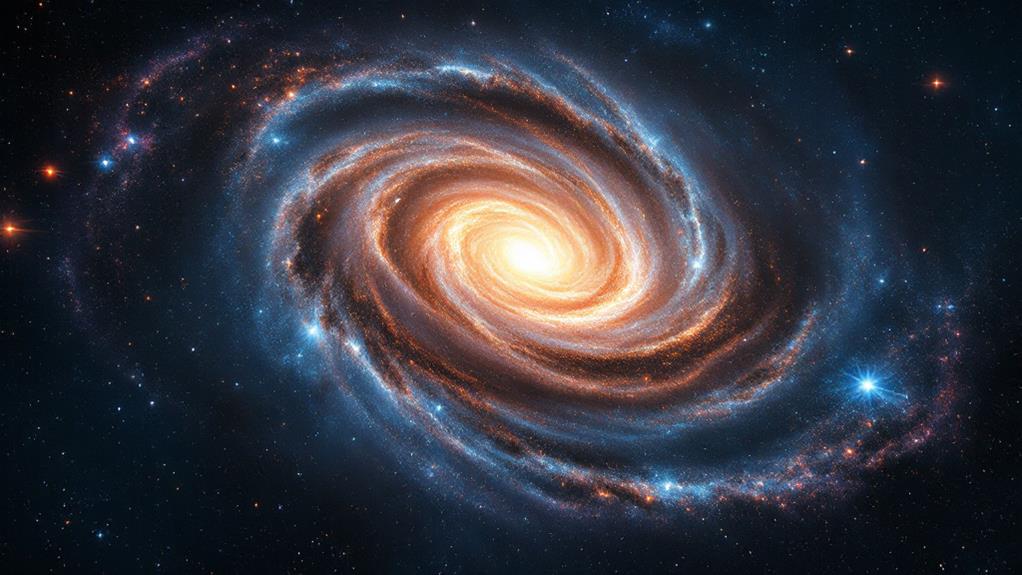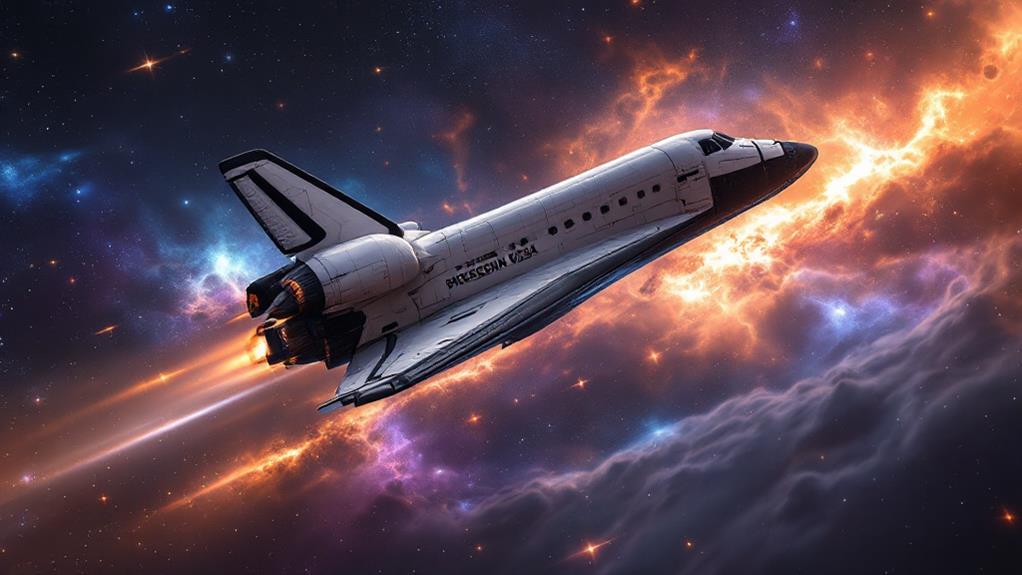Amazing Facts About the Big Bang Theory: How the Universe Was Born
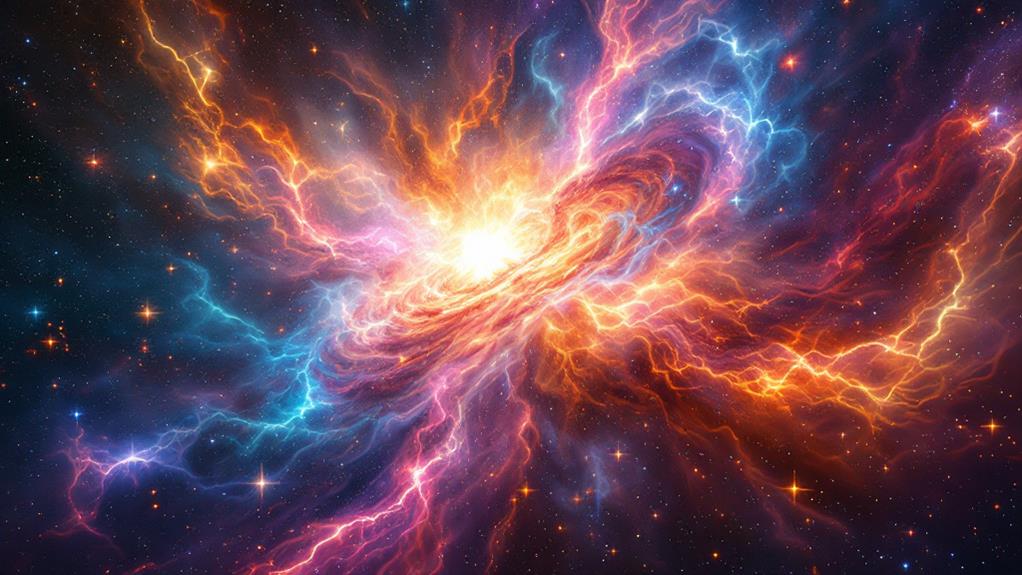
The Big Bang theory reveals mind-blowing facts about our universe's birth. You'll uncover that the cosmic microwave background offers a glimpse into the universe's infancy, while inflation explains its rapid expansion. The matter-antimatter asymmetry puzzle will intrigue you, and you'll learn how primordial elements formed in the cosmic furnace. Cosmic sound waves and dark matter played pivotal roles in shaping our universe, and ongoing expansion continues to influence its evolution. Alternative theories challenge the Big Bang model, adding complexity to our comprehension. Prepare to have your cosmic curiosity ignited as you investigate the universe's origins.
The Cosmic Microwave Background
The Cosmic Microwave Background, unearthed in 1964 by Arno Penzias and Robert Wilson, serves as one of the strongest pieces of evidence for the Big Bang theory. This faint glow of radiation permeates the entire universe, offering a glimpse into its infancy. You're essentially seeing the afterglow of the Big Bang when you observe this radiation.
What's extraordinary about the Cosmic Microwave Background is its uniformity. It's nearly the same temperature in all directions, which supports the idea of cosmic inflation. This theory suggests that the universe expanded rapidly in its earliest moments, smoothing out any irregularities.
Recent findings have further reinforced the Big Bang theory. In 2014, scientists detected gravitational waves in the Cosmic Microwave Background, providing direct evidence of cosmic inflation. These ripples in spacetime offer understanding into the universe's earliest moments, mere fractions of a second after the Big Bang.
Inflation and Rapid Expansion
Rapidity characterizes the universe's earliest moments, according to the theory of cosmic inflation. This concept, proposed by physicist Alan Guth in 1980, suggests that the universe underwent an exponential expansion just after the Big Bang. In a fraction of a second, the cosmos grew from a subatomic size to roughly the size of a grapefruit.
During this rapid inflation, quantum fluctuations—tiny variations in the fabric of spacetime—were stretched to cosmic scales. These fluctuations became the seeds for the large-scale structure we observe in the universe today, including galaxies and galaxy clusters.
You might wonder about the evidence for this theory. Scientists have found support in the uniformity of the cosmic microwave background and the flatness of space. Additionally, the detection of gravitational waves by the BICEP2 experiment in 2014 initially seemed to confirm inflation, though this claim was later retracted.
Inflation explains several puzzles about our universe, such as why it appears so uniform on large scales and why it's so close to being geometrically flat. While not definitively proven, cosmic inflation remains a cornerstone of modern cosmology, shaping our understanding of the universe's earliest moments.
Matter-Antimatter Asymmetry
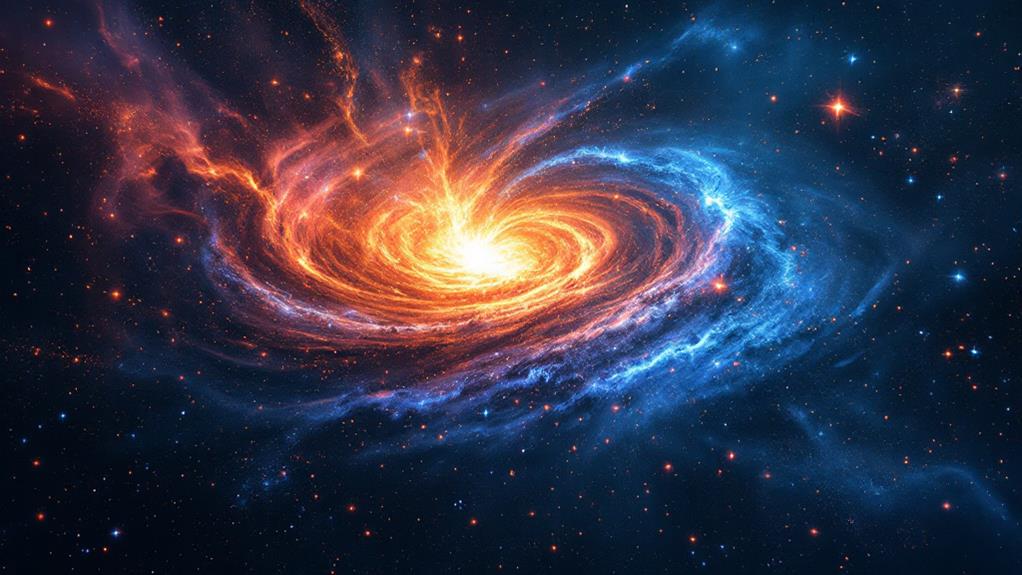
One of the most perplexing mysteries in cosmology is the matter-antimatter asymmetry observed in our universe. You might wonder why this asymmetry exists and how it's possible. According to the Big Bang theory, equal amounts of matter and antimatter should have been created during the universe's early stages. However, that's not what we observe today.
The universe you see around you is made almost entirely of matter, with very little antimatter present. This imbalance is essential for your existence, as matter and antimatter annihilate each other upon contact. If they were in equal quantities, they would have destroyed each other completely, leaving nothing behind.
Scientists have proposed various theories to explain this asymmetry, focusing on matter production processes and antimatter annihilation mechanisms. Some suggest that there might be unknown physical laws that favor matter over antimatter. Others hypothesize that antimatter might exist in separate regions of the universe, isolated from matter. Despite extensive research, the exact cause of this asymmetry remains unknown, making it one of the most intriguing puzzles in modern physics.
Primordial Elements
While the Big Bang theory explains the universe's origin, it also sheds light on the creation of the first elements. As the universe rapidly expanded and cooled, the nucleosynthesis process began, forging the primordial elements. During the first three minutes after the Big Bang, only the lightest elements formed: hydrogen, helium, and trace amounts of lithium.
You might wonder why heavier elements didn't appear immediately. The answer lies in the universe's rapid expansion and cooling, which prevented the formation of more complex nuclei. The primordial density fluctuations, tiny variations in matter distribution, played an essential role in this process. These fluctuations later became the seeds for galaxy formation.
It's fascinating to realize that about 75% of the universe's visible matter is hydrogen, while helium makes up nearly 25%. All other elements account for less than 1% of visible matter. The heavier elements you encounter daily, like carbon, oxygen, and iron, were forged much later in the hearts of stars through stellar nucleosynthesis. This cosmic cooking process continues today, with stars constantly creating and dispersing new elements throughout the universe.
Cosmic Sound Waves

Cosmic sound waves, also known as baryon acoustic oscillations, are among the most intriguing phenomena in cosmology. These primordial ripples in space-time originated in the early universe, just moments after the Big Bang. As the cosmos expanded and cooled, these sound waves left an imprint on the distribution of matter throughout the universe.
You can think of cosmic sound waves as massive pressure waves that propagated through the dense, hot plasma of the early universe. These waves were caused by the interplay between gravity pulling matter together and radiation pressure pushing it apart. As the universe cooled, these oscillations froze in place, creating a characteristic pattern in the cosmic density fluctuations.
Today, you can observe the effects of these ancient sound waves in the large-scale structure of the universe. They've left a distinct signature in the distribution of galaxies and dark matter, forming a cosmic web of filaments and voids. Astronomers use this pattern as a "standard ruler" to measure cosmic distances and study the expansion history of the universe, providing fundamental insights into dark energy and the fate of the cosmos.
Dark Matter's Role
Dark matter plays an essential role in our understanding of the Big Bang theory and the universe's evolution. Although it's invisible and doesn't interact with light, dark matter's gravitational influence shapes the cosmos we observe today. Scientists believe it accounts for about 85% of all matter in the universe, far outweighing visible matter.
In the early universe, dark matter's gravitational pull helped clump ordinary matter together, forming the first stars and galaxies. Without it, the universe would look vastly different, with matter spread too thinly to form large-scale structures. Dark matter continues to affect cosmic evolution, influencing the movement of galaxies and the formation of galaxy clusters.
Despite its importance, dark matter's unknown composition remains one of the biggest mysteries in physics. Scientists have proposed various candidates, from weakly interacting massive particles (WIMPs) to axions, but none have been definitively detected. Ongoing experiments aim to uncover dark matter's nature, using underground detectors, space-based instruments, and particle accelerators. Solving this puzzle could revolutionize our understanding of the universe's history and future, potentially leading to new physics beyond the Standard Model.
Ongoing Universal Expansion
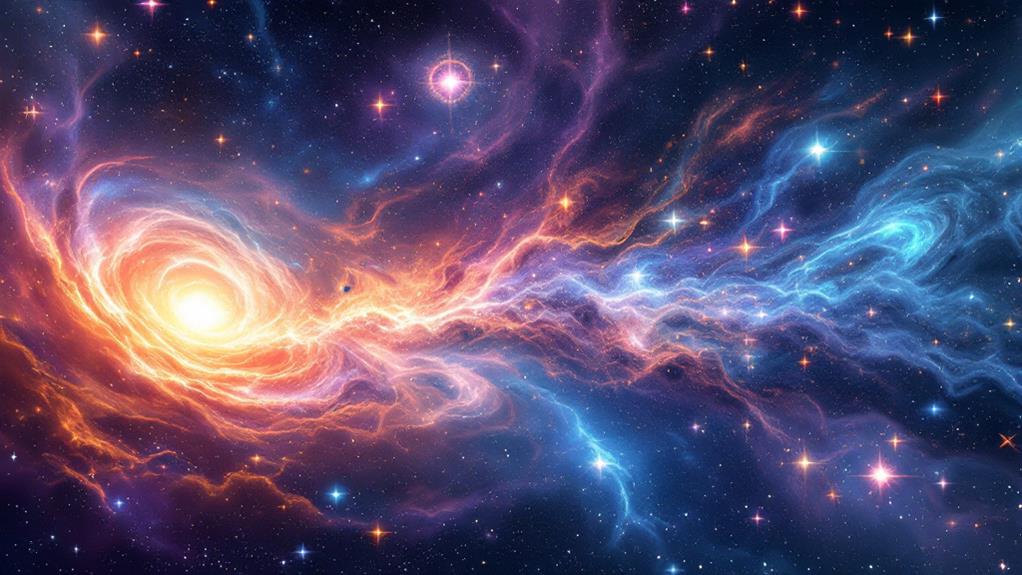
As the universe continues to expand, scientists are uncovering fascinating details about this ongoing process. You might be surprised to learn that this expansion is accelerating, driven by a mysterious force called dark energy. This phenomenon contradicts what you'd expect from gravity's pull, which should slow the expansion down.
The ongoing universal expansion affects how you perceive distant galaxies. As space stretches, light waves from far-off objects get stretched too, causing a redshift effect. This helps astronomers measure the universe's expansion rate and estimate its age.
Expansion also plays an essential role in the formation of cosmic structures. In the early universe, gravitational clustering led to the creation of galaxy clusters and superclusters. As expansion continues, it counteracts gravity's tendency to pull matter together, influencing the evolution of these structures.
You'll find that studying universal expansion provides valuable information into the early universe structure and helps scientists predict the cosmos' future. It's a key component in understanding the Big Bang theory and the fundamental nature of our ever-changing universe.
Alternative Theories and Challenges
The Big Bang theory's dominance doesn't mean it's without critics or alternatives. Scientists continue to challenge and refine our understanding of the universe's origins, proposing disputed cosmological models that offer alternative explanations.
One such theory is the Steady State model, which suggests the universe has always existed and continuously creates new matter to maintain a constant density. Another is the Oscillating Universe theory, proposing that the universe expands and contracts in cycles. The Ekpyrotic Universe model envisions our universe as one of many "branes" colliding in a higher-dimensional space.
Some scientists question the Big Bang's fundamental assumptions. They argue that the observed redshift of distant galaxies might not be due to expansion but to other factors like "tired light." Others challenge the interpretation of cosmic microwave background radiation or the abundance of light elements.
While these alternative theories haven't gained widespread acceptance, they encourage rigorous examination of the Big Bang model. As you investigate cosmology, remember that science evolves, and today's fringe ideas might become tomorrow's breakthroughs. The quest to understand our universe's birth continues, driven by curiosity and new revelations.
